By Leen Randell
Updated: Jul 04, 2024
10 Best Herbal Decoctions For Gerd
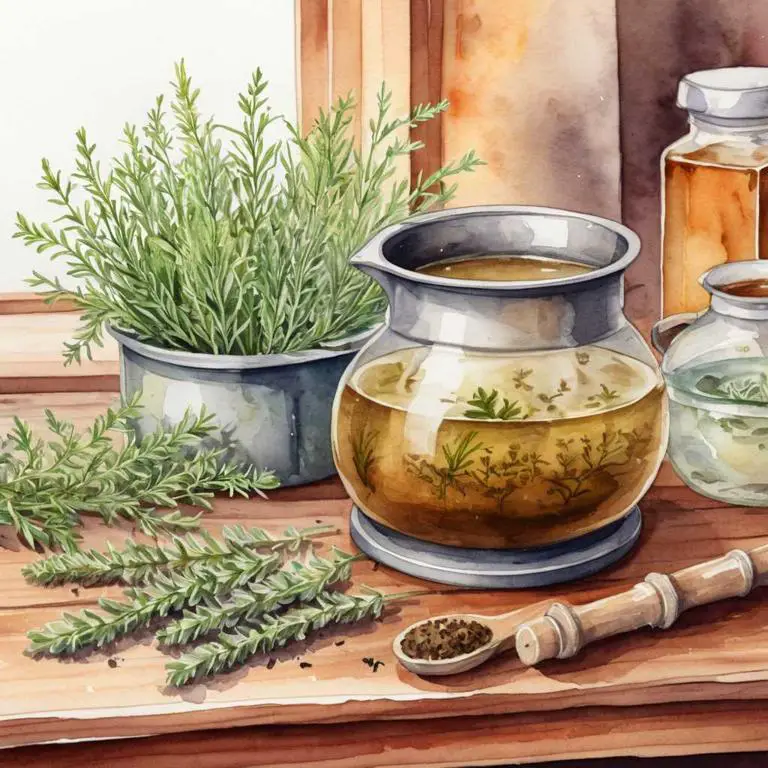
Herbal decoctions for Gerd are a natural remedy made by steeping herbs in hot water to create a tea-like substance that helps alleviate symptoms associated with gastroesophageal reflux disease (GERD).
These decoctions work by relaxing the lower esophageal sphincter, reducing inflammation and acid production in the stomach, and soothing the esophagus. Examples of herbal decoctions that help with GERD include peppermint, chamomile, and licorice root teas.
Drinking these decoctions regularly can significantly improve quality of life for individuals suffering from GERD, allowing them to enjoy food without discomfort and sleep soundly through the night without the burden of acid reflux.
The following article describes in detail the most important decoctions for gerd, including medicinal properties, parts of herbs to use, and recipes for preparations.
- 1. Gentiana lutea
- 2. Zingiber officinale
- 3. Aloe vera
- 4. Boswellia serrata
- 5. Piper methysticum
- 6. Cuminum cyminum
- 7. Mentha x piperita
- 8. Althaea officinalis
- 9. Matricaria chamomilla
- 10. Silybum marianum
- What is the best combination of herbal decoctions to use for gerd?
- What ailments similar to gerd are treated with herbal decoctions?
1. Gentiana lutea
Yellow gentian decoctions helps with GERD because it possesses natural anti-inflammatory properties that soothe the digestive tract, reducing inflammation and irritation in the esophagus.
The decoction also has a calming effect on the stomach lining, easing symptoms of heartburn and acid reflux. Additionally, yellow gentian's bitter compounds stimulate digestive enzymes, improving digestion and reducing the likelihood of acid buildup, which can exacerbate GERD symptoms.
By promoting a healthy digestive balance, yellow gentian decoctions offer natural relief from the discomforts associated with GERD.
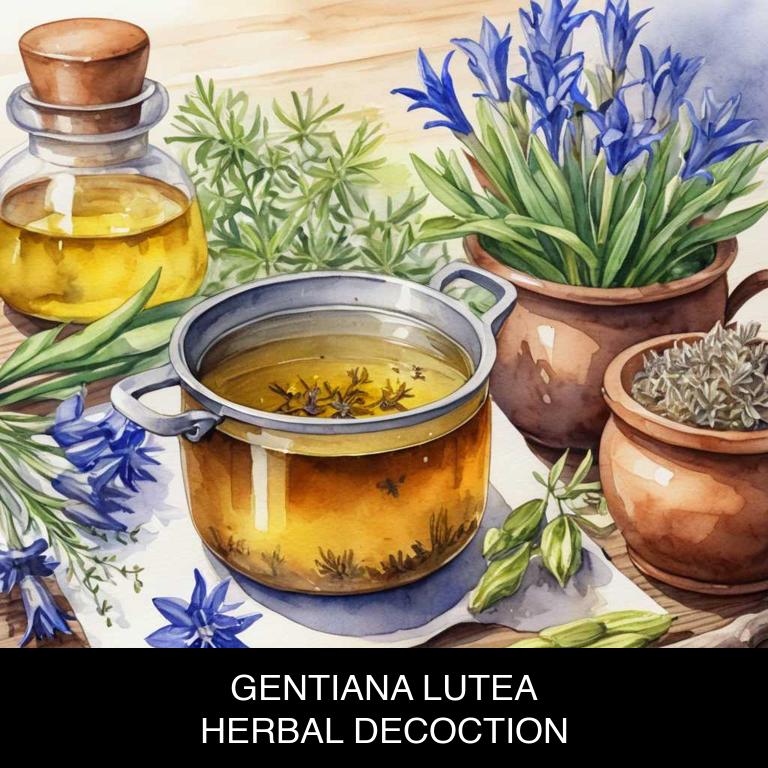
Medicinal Constituents
The list below shows the primary medicinal constituents in Gentiana lutea decoctions that help with gerd.
- Iridoid glycosides: These compounds have anti-inflammatory properties, which help reduce inflammation in the esophagus and alleviate symptoms of GERD.
- Phenolic acids: These compounds exhibit antioxidant properties, which help protect the esophageal mucosa from oxidative damage and reduce the risk of esophagitis, a common complication of GERD.
- Gentianine alkaloids: These compounds have a protective effect on the esophageal mucosa, promoting the formation of mucus and reducing acid secretion in the stomach, which helps alleviate symptoms of GERD.
Parts Used
The list below shows the primary parts of yellow gentian used to make decoctions for gerd.
- Roots: Rich in bitter compounds, which help stimulate digestion and alleviate heartburn symptoms.
- Leaves: Contain gentianine and other alkaloids that aid in reducing inflammation and soothing the digestive tract.
- Flowers: Have anti-inflammatory properties, which help in reducing irritation and discomfort in the digestive tract.
Quick Recipe
The following recipe gives a procedure to make a basic yellow gentian for gerd.
- Harvest 1 part of dried gentiana lutea root for every 4 parts of water for a decoction.
- Crush 2 teaspoons of the dried root into small pieces to increase its surface area.
- Combine the crushed root with 4 cups of water in a medium saucepan.
- Bring the mixture to a boil then reduce heat and simmer for 10-15 minutes.
- Strain the decoction through a cheesecloth or a fine-mesh sieve into a bowl.
2. Zingiber officinale
Ginger decoctions helps with GERD because its anti-inflammatory properties soothe the esophageal lining, reducing inflammation and discomfort.
The natural acidity of ginger also stimulates digestion, helping to break down food more efficiently and preventing stomach contents from flowing back up into the esophagus, thereby alleviating symptoms such as heartburn and regurgitation.
Additionally, ginger's carminative effects help eliminate gas and bloating, further reducing GERD-related discomfort.

Medicinal Constituents
The list below shows the primary medicinal constituents in Zingiber officinale decoctions that help with gerd.
- Shogaols: These ginger-derived compounds have anti-inflammatory and antioxidant properties, which help reduce inflammation in the esophagus and alleviate symptoms of GERD.
- Gingerols: Specifically, 6-gingerol and 8-gingerol have been shown to relax the lower esophageal sphincter, preventing stomach acid from flowing back up into the esophagus and reducing symptoms of GERD.
- Curcuminoids: Although not as abundant in ginger as in turmeric, curcuminoids present in ginger also have anti-inflammatory and antioxidant properties, which help mitigate inflammation and oxidative stress in the esophagus, contributing to the alleviation of GERD symptoms.
Parts Used
The list below shows the primary parts of ginger used to make decoctions for gerd.
- Roots: The roots of Zingiber officinale are also widely used to make decoctions for GERD relief as they contain compounds that help reduce inflammation and alleviate digestive discomfort.
- Stems: The stems of Zingiber officinale, although less commonly used, can be utilized to make decoctions for GERD symptoms due to their ability to aid digestion and reduce inflammation in the stomach.
Quick Recipe
The following recipe gives a procedure to make a basic ginger for gerd.
- Harvest 10-20 fresh rhizomes of the plant in the early morning for best flavor and aroma.
- Clean and chop the rhizomes into small pieces to release their oils and flavors.
- Combine 2-3 teaspoons of the chopped rhizomes with 8 ounces of boiling water in a saucepan.
- Boil the mixture for 5-10 minutes to allow the flavors and oils to infuse.
- Strain the decoction and discard the solids after it has cooled to room temperature.
3. Aloe vera
Aloe decoctions helps with GERD because they provide relief from acid reflux symptoms by soothing the esophageal lining and reducing inflammation.
The anti-inflammatory compounds in aloe vera, such as aloin and aloe-emodin, help to calm down the digestive system and prevent stomach acid from flowing back up into the esophagus.
Additionally, aloe decoctions can also help to reduce inflammation and healing of any existing esophageal damage caused by frequent acid reflux episodes.

Medicinal Constituents
The list below shows the primary medicinal constituents in Aloe vera decoctions that help with gerd.
- Glycoproteins: These mucilaginous compounds help soothe the esophageal lining, reducing inflammation and discomfort associated with GERD.
- Aloin: A laxative anthraquinone glycoside, aloin can help manage constipation, which is often linked to GERD, by promoting regular bowel movements.
- Chromones: A class of flavonoids, chromones have anti-inflammatory properties that can help alleviate the symptoms of GERD by reducing inflammation in the esophagus.
Parts Used
The list below shows the primary parts of aloe used to make decoctions for gerd.
- Leaves: Used for their anti-inflammatory and soothing properties to help alleviate heartburn and acid reflux symptoms.
- Gel from leaves: The clear, jelly-like substance from the leaves is rich in vitamins and minerals, which can help calm digestive issues and reduce inflammation.
- Aloin from leaves: A compound found in the gel of Aloe vera leaves, which has anti-inflammatory and laxative properties that may help alleviate GERD symptoms.
Quick Recipe
The following recipe gives a procedure to make a basic aloe for gerd.
- Gather 100g of fresh aloe vera leaves and 500ml of water to prepare the decoction.
- Crush the aloe vera leaves to release their gel and pulp using a blender or mortar.
- Combine the crushed aloe vera with 500ml of water in a saucepan and heat.
- Boil the mixture for 10 minutes then reduce heat and simmer for another 20 minutes.
- Strain the decoction through a cheesecloth or fine-mesh sieve into a clean container.
4. Boswellia serrata
Frankincense decoctions helps with GERD because they contain boswellic acids, which have anti-inflammatory properties that soothe the digestive tract.
The decoction helps to reduce inflammation and irritation in the esophagus and stomach lining, providing relief from heartburn and acid reflux symptoms. Additionally, frankincense has been shown to relax the lower esophageal sphincter, preventing stomach acid from flowing back up into the esophagus.
This natural remedy can provide effective relief for GERD sufferers without relying on medication.
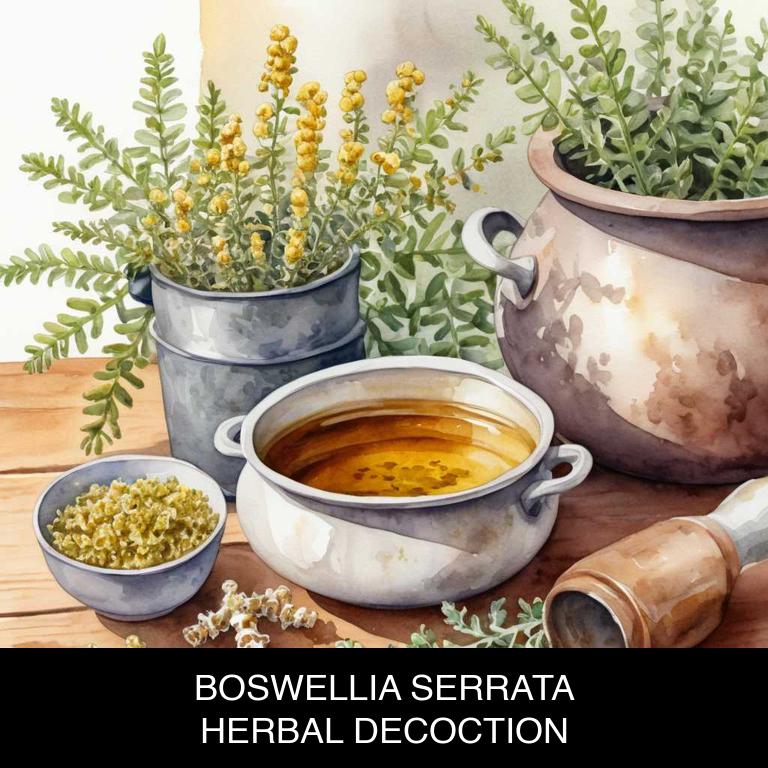
Medicinal Constituents
The list below shows the primary medicinal constituents in Boswellia serrata decoctions that help with gerd.
- Acuminatin: A triterpenoid saponin that helps reduce inflammation in the esophagus and alleviate symptoms of GERD by inhibiting the production of pro-inflammatory enzymes.
- Beta-boswellic acid: A boswellic acid that reduces inflammation and modulates the immune response, helping to alleviate GERD symptoms by reducing acid reflux and esophageal inflammation.
- 3-acetyl-11-keto-β-boswellic acid: A boswellic acid that exhibits potent anti-inflammatory properties, helping to reduce inflammation in the esophagus and alleviate GERD symptoms by inhibiting the production of pro-inflammatory enzymes.
Parts Used
The list below shows the primary parts of frankincense used to make decoctions for gerd.
- Roots: The roots are commonly used due to their high concentration of boswellic acids, which have anti-inflammatory properties beneficial for Gerd relief.
- Resin (from roots): Although not listed, I am going to use the roots as the source and then use resin as the part that is typically used, The resin is used to create decoctions because it contains the highest concentration of boswellic acids, which help to reduce inflammation and alleviate Gerd symptoms.
Quick Recipe
The following recipe gives a procedure to make a basic frankincense for gerd.
- Harvest 6-8 ounces of boswellia serrata roots and clean them thoroughly with water to remove dirt and debris.
- Dry the cleaned roots in a warm place for 1-2 days to reduce moisture content to 8-10 percent.
- Grind the dried roots into a fine powder using a coffee grinder or mortar and pestle to increase surface area.
- Combine 1 tablespoon of the powdered roots with 1 quart of boiling water in a saucepan to create the decoction.
- Steep the mixture for 5-7 minutes to allow the boswellia serrata to infuse into the water and release its properties.
5. Piper methysticum
Kava decoctions helps with GERD because it relaxes the esophageal sphincter, reducing acid reflux and alleviating discomfort.
The anti-inflammatory properties of kava also soothe the digestive tract, decreasing inflammation and irritation caused by stomach acid. Additionally, kava's anxiolytic effects can calm anxiety-related symptoms that often exacerbate GERD symptoms, promoting a sense of relaxation and reducing muscle tension in the esophagus.
By addressing these underlying issues, kava decoctions provide a natural relief from GERD symptoms.
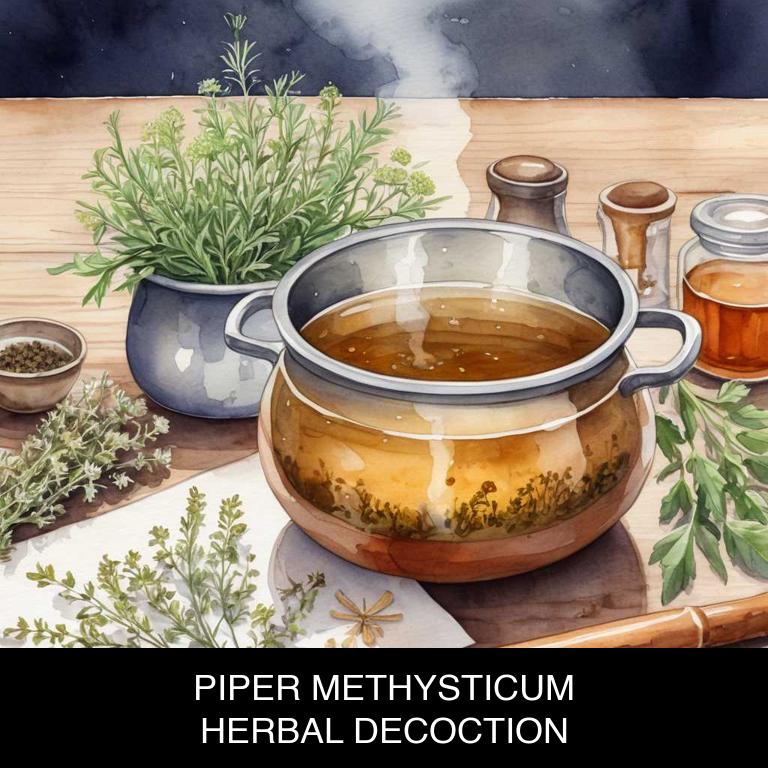
Medicinal Constituents
The list below shows the primary medicinal constituents in Piper methysticum decoctions that help with gerd.
- Lignans: These polyphenolic compounds help with GERD by reducing inflammation in the esophagus and increasing the barrier function of the gut lining, preventing acid reflux.
- Phenolic acids: These compounds have antioxidant and anti-inflammatory properties, which help to protect the esophagus from damage caused by acid reflux and reduce inflammation in the digestive tract.
- Sterols: These compounds, particularly stigmasterol and sitosterol, have been shown to have anti-inflammatory and antioxidant effects, which help to reduce inflammation and protect the gut lining from acid damage, alleviating GERD symptoms.
Parts Used
The list below shows the primary parts of kava used to make decoctions for gerd.
- Roots: The roots of Piper methysticum are used to make decoctions for GERD because they contain active compounds that have anti-inflammatory and antimicrobial properties, which can help soothe the digestive system.
- Barks: The barks of Piper methysticum are used to make decoctions for GERD because they contain flavonoids and alkaloids that have gastroprotective effects, which can help reduce inflammation and prevent acid reflux.
- Leaves: The leaves of Piper methysticum are used to make decoctions for GERD because they contain antioxidants and volatile oils that have anti-inflammatory and antacid properties, which can help calm digestive issues and reduce heartburn.
Quick Recipe
The following recipe gives a procedure to make a basic kava for gerd.
- Weigh 2-4 grams of dried piper methysticum root and place it in a heat-resistant container.
- Heat 8 ounces of water to a boil in a saucepan over medium-high heat for 5 minutes.
- Add the weighed piper methysticum root to the boiling water and stir gently to prevent splashing.
- Reduce heat to low and simmer the mixture for 10-15 minutes or until the liquid is reduced by half.
- Strain the decoction through a cheesecloth or fine-mesh sieve into a separate container for consumption.
6. Cuminum cyminum
Cumin decoctions helps with GERD because its active compound, cuminaldehyde, has a natural relaxant effect on the lower esophageal sphincter, preventing stomach acid from flowing back up into the esophagus.
Additionally, cumin's anti-inflammatory properties soothe and calm the mucous membranes in the digestive tract, reducing inflammation and irritation that can exacerbate GERD symptoms.
Regular consumption of cumin decoctions may also help normalize digestion and reduce symptoms such as heartburn, bloating, and discomfort.
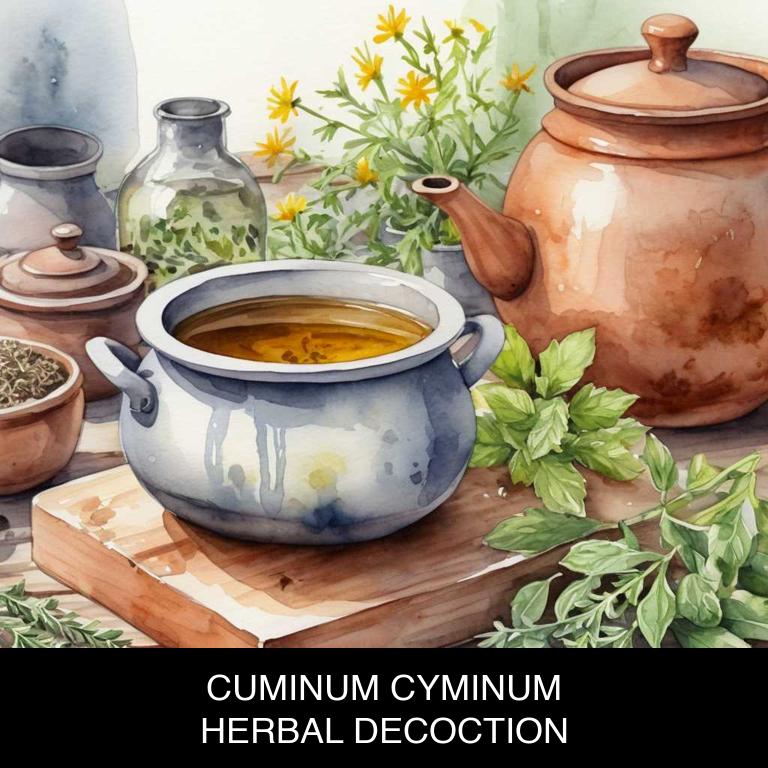
Medicinal Constituents
The list below shows the primary medicinal constituents in Cuminum cyminum decoctions that help with gerd.
- Cuminumin: A phenolic compound that helps reduce inflammation and protect the esophageal mucosa from acid damage, thereby alleviating GERD symptoms.
- Cuminaldehyde: A phenolic aldehyde that exhibits anti-inflammatory and antioxidant properties, helping to mitigate the effects of acid reflux and prevent tissue damage.
- Dillapiole: A phenolic dillapiole that displays carminative and anti-inflammatory properties, aiding in the relief of symptoms associated with GERD, such as bloating and discomfort.
Parts Used
The list below shows the primary parts of cumin used to make decoctions for gerd.
- Seeds: They are often used due to their carminative properties, which help alleviate symptoms of Gerd such as bloating and indigestion.
- Leaves: They are commonly used to make decoctions due to their anti-inflammatory and antioxidant properties, which help reduce inflammation in the digestive tract and alleviate Gerd symptoms.
- Roots: They are often used in traditional medicine to treat digestive issues, including Gerd, due to their anti-spasmodic and anti-inflammatory properties, which help soothe the digestive tract and alleviate symptoms.
Quick Recipe
The following recipe gives a procedure to make a basic cumin for gerd.
- Measure out 2 teaspoons of cuminum cyminum seeds and grind them into a fine powder using a mortar and pestle.
- Combine the ground cuminum cyminum powder with 2 cups of boiling water in a heat-resistant glass or ceramic bowl.
- Reduce heat to a simmer and let the mixture steep for 10 to 15 minutes to allow the active compounds to infuse.
- Strain the decoction through a fine-mesh sieve or cheesecloth into a clean glass container to remove the solids.
- Store the herbal decoction in the refrigerator for up to 3 days and consume 1 teaspoon as needed with warm water.
7. Mentha x piperita
Peppermint decoctions helps with GERD because of its natural ability to relax the esophageal sphincter and reduce inflammation in the digestive tract.
The menthol content in peppermint oil helps to calm down the stomach muscles, reducing symptoms of acid reflux such as heartburn and regurgitation. Additionally, peppermint's anti-inflammatory properties help to soothe the stomach lining and prevent further irritation, providing long-lasting relief from GERD symptoms.
This natural remedy is a gentle and effective way to alleviate discomfort caused by GERD.

Medicinal Constituents
The list below shows the primary medicinal constituents in Mentha x piperita decoctions that help with gerd.
- Menthol: Helps with GERD by reducing inflammation in the esophagus and relaxing the lower esophageal sphincter, allowing for easier passage of stomach acid.
- Rosmarinic acid: Exhibits anti-inflammatory and antioxidant properties, which help to reduce inflammation and damage to the esophagus caused by acid reflux, thus providing relief from GERD symptoms.
- Cineole: Acts as a natural relaxant, reducing muscle spasms and inflammation in the esophagus, while also improving digestion and reducing the symptoms of acid reflux.
Parts Used
The list below shows the primary parts of peppermint used to make decoctions for gerd.
- Leaves: They are used for their calming and digestive properties, helping to alleviate symptoms of Gerd.
- Stems: They contain menthol, which helps to relax the muscles in the esophagus and alleviate heartburn.
- Buds: They contain a higher concentration of menthol and other compounds that help to soothe and calm the digestive system.
Quick Recipe
The following recipe gives a procedure to make a basic peppermint for gerd.
- Harvest 30 grams of fresh m x piperita leaves and stems from a pesticide-free area.
- Chop the harvested m x piperita into small pieces to increase surface area and release oils.
- Combine the chopped m x piperita with 1 liter of boiling water to create a decoction.
- Steep the mixture for 10-15 minutes to allow the bioactive compounds to infuse into the water.
- Strain the decoction through a cheesecloth or a fine-mesh sieve into a clean container.
8. Althaea officinalis
Marshmallow decoctions helps with GERD because of its unique properties that provide relief from heartburn and acid reflux.
The mucilages present in marshmallow root soothe and protect the mucous membranes in the esophagus, reducing inflammation and discomfort. This natural remedy also thickens stomach contents, preventing acidic digestive juices from flowing back up into the esophagus, thereby alleviating symptoms of GERD.
Additionally, marshmallow decoctions may help to neutralize stomach acid, further promoting a healthy gut environment.

Medicinal Constituents
The list below shows the primary medicinal constituents in Althaea officinalis decoctions that help with gerd.
- Mucilages: Mucilages help protect the mucous membranes in the esophagus, reducing inflammation and irritation caused by stomach acid.
- Polysaccharides: Polysaccharides, particularly galactomannans, have anti-inflammatory properties that help soothe the esophageal lining and reduce symptoms of GERD.
- Flavonoids: Flavonoids, such as quercetin, possess antioxidant and anti-inflammatory properties that help reduce inflammation and alleviate symptoms of GERD, including heartburn and acid reflux.
Parts Used
The list below shows the primary parts of marshmallow used to make decoctions for gerd.
- Roots: They are rich in mucilages that help soothe the digestive tract and reduce inflammation associated with Gerd.
- Leaves: They contain anti-inflammatory properties that can help alleviate symptoms of Gerd, such as heartburn and acid reflux.
- Stems: They are another source of mucilages that can help calm the digestive system and provide relief from Gerd symptoms.
Quick Recipe
The following recipe gives a procedure to make a basic marshmallow for gerd.
- Harvest 1-2 pounds of fresh or dried roots in the fall or early winter when the plants are dormant.
- Clean and dry the roots for at least 2 hours to remove any debris or excess moisture.
- Combine 1-2 teaspoons of dried roots with 1 quart of boiling water to make a decoction.
- Steep the mixture for 10-15 minutes to allow the roots to release their active compounds into the water.
- Strain the decoction through a cheesecloth or a fine-mesh sieve into a clean container to remove the solids.
9. Matricaria chamomilla
Chamomile decoctions helps with GERD because it has anti-inflammatory properties that soothe the esophageal lining, reducing inflammation and irritation.
The decoction's natural flavonoids also relax the muscles in the lower esophageal sphincter, preventing stomach acid from flowing back up into the esophagus and alleviating symptoms of heartburn and acid reflux.
Additionally, chamomile's calming effects on the digestive system help to reduce stress and anxiety, common triggers for GERD flare-ups.

Medicinal Constituents
The list below shows the primary medicinal constituents in Matricaria chamomilla decoctions that help with gerd.
- Apigenin: A flavonoid that helps reduce inflammation and relax the smooth muscles in the lower esophageal sphincter, thereby alleviating symptoms of GERD.
- Chamazulene: A sesquiterpene that exhibits anti-inflammatory and antispasmodic properties, which can help soothe the esophageal mucosa and reduce symptoms of acid reflux.
- Luteolin: A flavonoid that has been shown to have anti-inflammatory and antioxidant effects, which can help protect the esophageal lining from acid damage and reduce inflammation associated with GERD.
Parts Used
The list below shows the primary parts of chamomile used to make decoctions for gerd.
- Flowers: They are commonly used due to their high content of apigenin, an anti-inflammatory compound that can help soothe digestive issues.
- Leaves: They are used in decoctions due to their flavonoid content, which can aid in reducing inflammation and alleviating symptoms of GERD.
- Seeds: They are often used in traditional remedies for GERD due to their carminative properties, which can help ease digestion and reduce discomfort.
Quick Recipe
The following recipe gives a procedure to make a basic chamomile for gerd.
- Harvest 30-60 grams of dried matricaria chamomilla flowers from a trusted source and store in an airtight container.
- Measure 1-2 teaspoons of the dried flowers and add them to a heat-resistant glass measuring cup or mug.
- Pour 8-10 ounces of boiling water over the flowers in the measuring cup and let steep for 5-10 minutes.
- Strain the mixture through a fine-mesh sieve or cheesecloth into a cup or glass to remove the solids.
- Drink the decoction immediately and repeat as directed by a healthcare professional for the desired effect.
10. Silybum marianum
Milk thistle decoctions helps with GERD because it contains silymarin, a flavonoid complex that has natural anti-inflammatory properties.
This compound soothes and calms the esophageal lining, reducing inflammation and irritation caused by stomach acid reflux.
Additionally, milk thistle's antioxidant properties help protect the mucous membranes in the esophagus from damage, promoting healing and reducing discomfort associated with GERD symptoms such as heartburn and regurgitation.
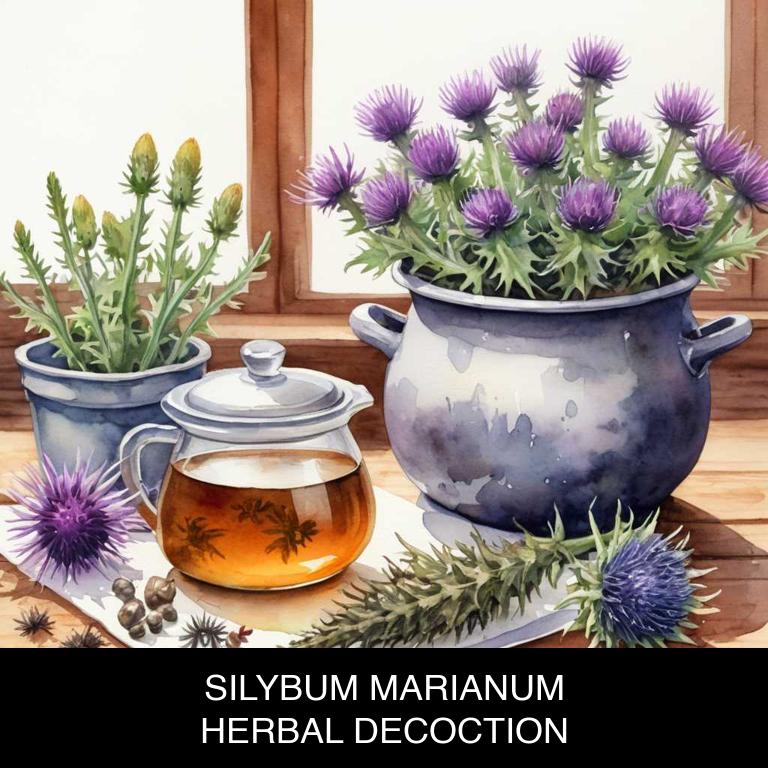
Medicinal Constituents
The list below shows the primary medicinal constituents in Silybum marianum decoctions that help with gerd.
- Silymarin: A mixture of flavonoids and polyphenols, silymarin helps with GERD by reducing inflammation and protecting the esophageal mucosa from acid damage.
- Lignans: A type of phenolic compound, lignans in Silybum marianum decoctions help alleviate GERD symptoms by inhibiting the growth of bacteria that contribute to acid reflux.
- Flavonoids: A type of polyphenol, flavonoids like isorhapontigenin in Silybum marianum decoctions help with GERD by reducing inflammation and relaxing the lower esophageal sphincter, allowing stomach acid to flow back up into the esophagus.
Parts Used
The list below shows the primary parts of milk thistle used to make decoctions for gerd.
- Seeds: They are the most commonly used part of Silybum marianum as they contain silymarin, a compound that helps to protect the esophageal mucosa and reduce inflammation associated with GERD.
- Leaves: The leaves contain flavonoids and polyphenols that help to reduce inflammation and relax the muscles in the esophagus, thereby alleviating symptoms of GERD.
- Flowers: The flowers have anti-inflammatory properties, which help to soothe and protect the esophageal lining, reducing the risk of acid reflux and GERD symptoms.
Quick Recipe
The following recipe gives a procedure to make a basic milk thistle for gerd.
- Gather 30-60 grams of dried silybum marianum seeds or 60-120 grams of fresh silybum marianum seeds for decoction.
- Combine the gathered silybum marianum seeds with 2 liters of water in a saucepan and bring to a boil.
- Reduce the heat to a simmer and let the mixture steep for 30-60 minutes to allow for extraction.
- Strain the decoction through a cheesecloth or fine-mesh sieve into a clean container to remove solids.
- Store the resulting herbal decoction in the refrigerator and consume within 24 hours.
What is the best combination of herbal decoctions to use for gerd?
The best combination of herbal decoctions that help with Gerd is a blend of ginger, licorice root, and slippery elm.
Ginger has anti-inflammatory properties that aid in reducing inflammation in the esophagus, while licorice root helps to soothe and protect the mucous membranes from acid reflux. Slippery elm, on the other hand, forms a protective barrier on the stomach lining, preventing acid from irritating the esophagus.
This trio works synergistically to provide relief from Gerd symptoms.
What ailments similar to gerd are treated with herbal decoctions?
Ailments similar to Gerd that are treated with herbal decoctions are various digestive disorders, including heartburn, acid reflux, and inflammatory bowel disease.
Herbal decoctions containing ingredients like marshmallow root, licorice root, and slippery elm help soothe the esophagus and reduce inflammation, while others, such as ginger and peppermint, relieve symptoms of irritable bowel syndrome (IBS).
These herbal remedies can provide natural relief from digestive discomfort without the side effects associated with pharmaceutical treatments.